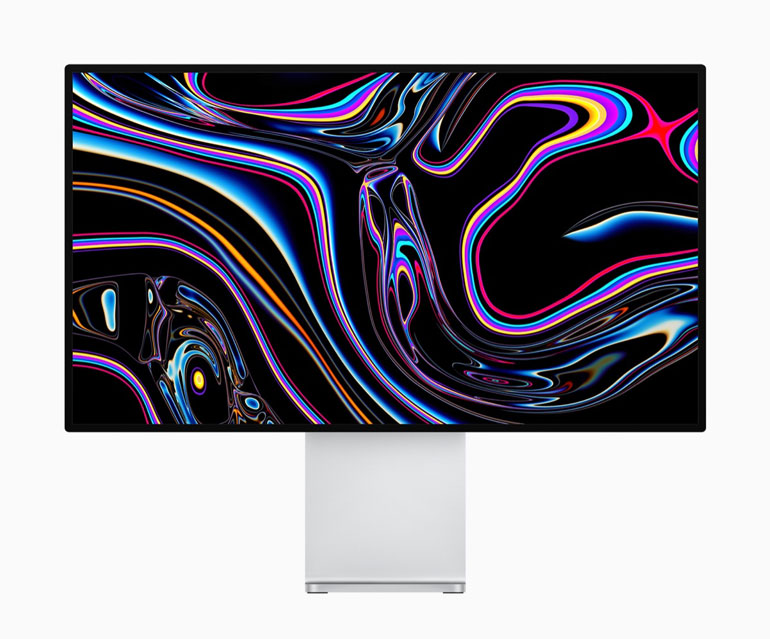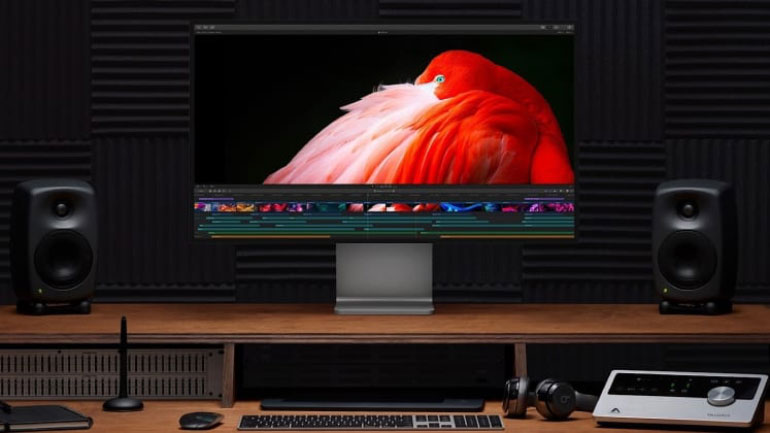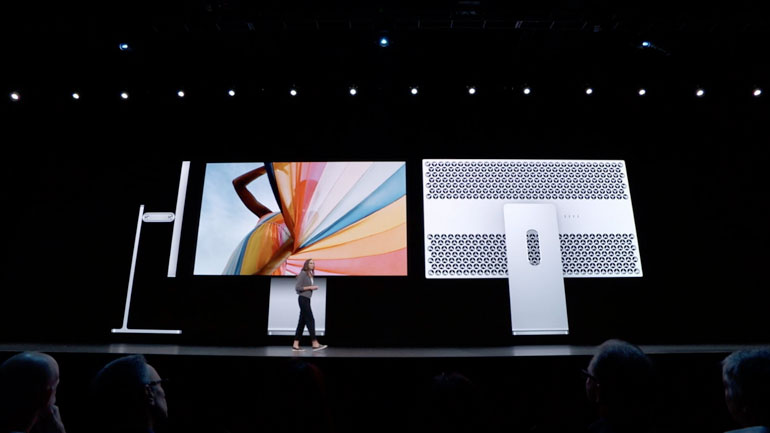An Inside Look at the New Apple Pro Display XDR and Blackmagic Design’s Teranex Mini SDI to DisplayPort 8K HDR
By Adam Goldfine - DNA Cinema Services

As you probably know, the latest Mac Pro was announced a few weeks back to great fanfare. To best display all of the under-the-hood graphics horsepower contained in this beast of a machine, Apple also announced its first new monitor in over half a decade, the Pro Display XDR.
The 32” diagonal, 6K, Retina monitor, with “Extreme Dynamic Range," is capable of 1000 nits of sustained full screen brightness, 1600 nits of peak brightness, and starts at $4999 - stand sold separately.
While some have gasped at the price (the additional $999 for the stand was met with less than resounding enthusiasm), others have applauded its affordability, given its capabilities.
On the same day, and with a great deal less fanfare, Blackmagic Design announced the not nearly as sexy Teranex Mini SDI to DisplayPort 8K HDR. It converts an SDI signal to DisplayPort in resolutions up to 8K, and provides dual on-screen scope overlays, HDR, 33 point 3D LUTs and monitor calibration.
It has been specifically designed for the professional film and television market, and will be available in October 2019 for $1,295.
Taken separately, each device offers impressive, and in some areas groundbreaking performance for high end video and digital cinema professionals. Taken together they should offer a level of flexibility in system integration and unprecedented capabilities available at a fraction of the cost of the closest competition.
Blackmagic Teranex Mini SDI to DisplayPort 8K HDR
It’s no secret that SDI is the de-facto broadcast workflow standard. If you are adding the Apple Pro Display XDR to an existing SDI workflow, the Teranex Mini SDI to DisplayPort 8K HDR box allows you to seamlessly integrate the new display while retaining legacy functionality.

The Blackmagic Design box has quad-link 12G SDI inputs with loop-through, the ability to calibrate and store two front panel selectable 33 point 3D LUTs, will handle all current color gamuts, and supports HD resolutions from 720P to 8K.
It will simultaneously display any two user selectable monitoring scopes, including a waveform monitor, a vectorscope, RGB and YUV parade displays, and a histogram. It is expected to work with any DisplayPort monitor, and there is an HDMI version as well.

As part of a monitoring solution, the Teranex can be utilized in a production environment to interface between the SDI output of a digital cinema camera and the Pro Display XDR. In addition to feeding the SDI signal, the converter can switch reference color modes in the display to any of the available options. The monitor will remember the last reference mode that was set even if it is unplugged and moved to another location or used with another device.
As an end-to-end workflow solution within the Apple ecosystem, the Pro Display XDR was designed to connect directly to the Mac Pro over Thunderbolt 3. Thanks to a forthcoming release of DaVinci Resolve that allows the new monitor to run in full display mode, Resolve colorists will have a color managed solution that does not depend on the computer outputting SDI video.

Apple Pro Display XDR Monitor
The Pro Display XDR will ship with nine color reference modes. For example, the HDR Video (P3-ST 2084) mode, which will be selectable by going into Display Preferences in MacOS. As with the Teranex, the monitor will remember the selected color reference mode even when disconnected and moved to a new device.
Much has been made of the Pro Display XDR’s color accuracy. According to Apple, each unit will be calibrated in the company’s state of the art facility and shipped with extreme accuracy and repeatability.

Apple claims the display will hold its calibration over time. Nevertheless, in the pro world, the ability to calibrate and maintain calibration is essential. Colorists and clients alike must have complete confidence that the grading monitor represents an absolute color reference.
Field calibration of the Pro Display XDR will be possible using a spectroradiometer and Apple is currently working with Colorimetry Research and Photo Research to develop calibration solutions. Probes are expected to be available from other vendors as well.
Final Thoughts on Apple Pro Display and Blackmagic Teranex Mini SDI to DisplayPort
The question is then: can serious colorists, those working in high dollar per hour color suites replace their current reference with a Thunderbolt 3 connected (or Teranex adapted for SDI legacy systems) Pro Display XDR?
The answer from both Apple and Blackmagic Design is yes. And for Apple’s part, they aren’t just talking about replacing good enough (which is already pretty great) and competitively priced monitors. Apple is challenging the likes of the Flanders XM311K, the Sony BVM-HX310, the Canon DP-V2421, and others of their ilk, the least of which start slightly north of $30,000 and go significantly higher from there.

In that context the Pro Display XDR, with or without the Teranex Mini SDI to DisplayPort 8K HDR, makes sense. In today’s landscape, and for about the same price as the Apple monitor, including the stand, you can buy an Eizo CG319X, a 4K DCI, SDR monitor with about 350 nits of brightness and a 1500:1 contrast ratio. It has its own in-built calibration hardware but its performance is nowhere near that of the Pro Display XDR. The next step up in the Eizo range, the 31”, 4K DCI resolution, HDR capable PROMINENCE CG3145, carries an MSRP of nearly $31,000.
The soon to be released Atomos Neon Series looks promising with the 31” model being touted as a suitable Dolby Vision grading monitor. It has somewhat lower specs, and the price is higher than the Pro Display XDR at $7,999. It does have on-board 4K or 8K recording to a number of pro formats including ProRes RAW, as well as other impressive production capabilities. As a production monitor it may be an excellent choice.
With 6K, 218 pixel per inch resolution, 500 nit SDR brightness and 1000 nit sustained HDR brightness, 1,000,000:1 contrast ratio, and unparalleled color accuracy, Apple’s Pro Display XDR stands alone in the increasingly competitive reference monitor field. Add Blackmagic Design’s Mini SDI to DisplayPort 8K HDR and it becomes suitable for just about any production or post-production environment I can imagine.
Adam Goldfine Bio
After graduating from New York University’s Tisch School of the Arts, Adam landed his first professional film job working as a production assistant on Crocodile Dundee. As his skills and talent grew he began working as a lighting director, camera operator, and director of photography. His first feature film, Black Lights, White Shadows, gained international acclaim and attention and launched a career that includes 18 feature films, 15 feature length television projects and dozens of music videos, commercials, short films, and documentaries. He later ventured into the world of visual effects working for Academy Award Winner William Mesa, long considered one of the most innovative visual effects directors in the industry. He currently runs DNA Cinema Services, a boutique production company based in Phoenix, AZ.
Notable clients include CBS Studio Center, Panavision Hollywood, Polygram Filmed Entertainment, Wyle Electronics, HBO Films, Rysher Entertainment, MTV, CBS Television, NBC Television, PBS, Film Four – London, Warner Brothers Records, Atlantic Records, Sony/Columbia Records, Lucas Film, Paramount Pictures, EUE Screen Gems, Nintendo, Exxon, Estee Lauder and Drexel Burnham Lambert. He has worked with well known industry figures George Lucas, Tom Hanks, Paul Newman, Dennis Hopper, Kevin Pollak, Anthony LaPaglia, Paul Simon, Jillian Murray, and many others.